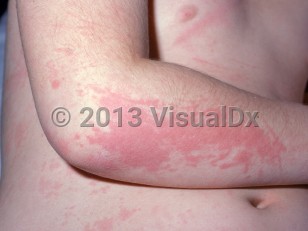The most widely adopted classification criteria for JIA is shown below, and it is based mostly on clinical presentation rather than disease pathophysiology. Attempts at incorporating biologic data into new classification criteria are underway, and may help to provide more homogeneous disease subsets in the future. Genetic factors are being investigated within subsets of these diseases.
- Oligoarthritis (fewer than 5 joints involved) – The most common type of JIA, seen in girls aged 2-4 years, it usually affects the lower extremities. This type of arthritis is often complicated by asymptomatic uveitis, a potentially sight-threatening condition; the presence of a positive ANA increases this risk.
- Rheumatoid factor (RF)-positive polyarthritis (5 or more joints involved) – Usually affects adolescent girls; presents with a symmetric arthritis of small joints (wrists and fingers) and a positive RF serology. This disease is the same as adult rheumatoid arthritis.
- RF-negative polyarthritis (5 or more joints involved) – A heterogeneous group; can have positive ANA and behave like oligoarthritis, or can resemble seronegative rheumatoid arthritis in adults.
- Psoriatic arthritis – Often affects children aged 2-4 years and 9-11 years. It is diagnosed when arthritis is seen in patients with psoriasis, or if there is dactylitis (swelling of a finger), nail pits, or a first-degree family member with psoriasis. Patients with nail, scalp, and inverse (intertriginous) psoriatic skin disease have a higher risk of developing psoriatic arthritis.
- Enthesitis-related arthritis – Usually affects boys aged older than 6 years and is characterized by enthesitis, or inflammation of the entheses (the region where tendons and ligaments insert into bone), commonly at the Achilles tendon or plantar fascia. It is associated with HLA-B27 and is often called seronegative spondyloarthropathy.
- Systemic arthritis – This disorder is characterized by the presence of arthritis and quotidian fevers, usually occurring at night, as well as an evanescent salmon-colored rash and systemic features such as hepatosplenomegaly, lymphadenopathy, leukocytosis, and elevations in inflammatory markers (ESR, CRP). Not all features of the disorder will be present at disease onset. It most often occurs in children aged younger than 5 years. This disorder is thought to represent an autoinflammatory disease, in which the innate immune system creates uncontrolled systemic inflammation. The development of macrophage activation syndrome can be fatal.
- Undifferentiated arthritis – Patients not meeting inclusion criteria for any disease or who meet more than 1 set of criteria are classified in this category.



 Patient Information for
Patient Information for 
